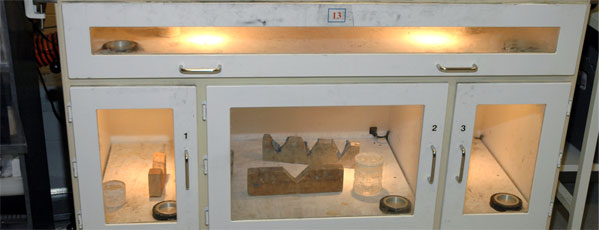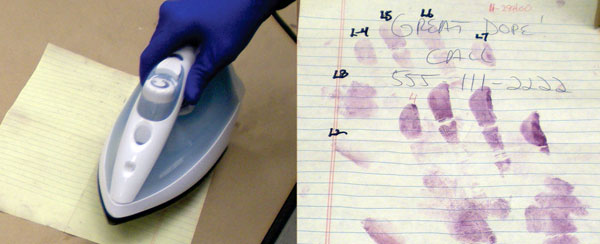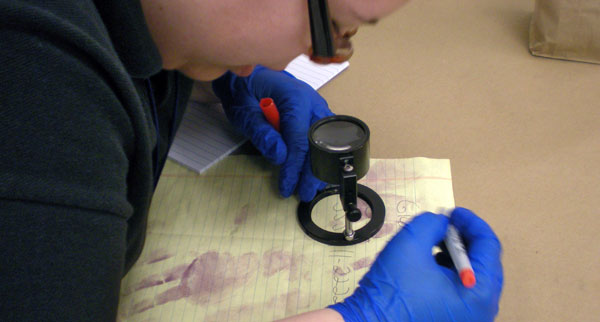How It’s Done
Where Fingerprints May be Found
Fingerprints can be found on practically any solid surface, including the human body. Analysts classify fingerprints into three categories according to the type of surface on which they are found and whether they are visible or not: Fingerprints on soft surfaces (such as soap, wax, wet paint, fresh caulk, etc.) are likely to be three-dimensional plastic prints; those on hard surfaces are either patent (visible) or latent (invisible) prints. Visible prints are formed when blood, dirt, ink, paint, etc., is transferred from a finger or thumb to a surface. Patent prints can be found on a wide variety of surfaces: smooth or rough, porous (such as paper, cloth or wood) or nonporous (such as metal, glass or plastic).
Latent prints are formed when the body’s natural oils and sweat on the skin are deposited onto another surface. Latent prints can be found on a variety of surfaces; however, they are not readily visible and detection often requires the use of fingerprint powders, chemical reagents or alternate light sources. Generally speaking, the smoother and less porous a surface is, the greater the potential that any latent prints present can be found and developed.
How Fingerprints are Collected
Collecting Patent Prints
Patent prints are collected using a fairly straightforward method: photography. These prints are photographed in high resolution with a forensic measurement scale in the image for reference. Investigators can improve the quality of the images by using low-angle or alternate light sources and/or certain chemicals or dyes during photography, but this is usually not necessary.
Collecting Latent Prints
One of the most common methods for discovering and collecting latent fingerprints is by dusting a smooth or nonporous surface with fingerprint powder (black granular, aluminum flake, black magnetic, etc.). If any prints appear, they are photographed as mentioned above and then lifted from the surface with clear adhesive tape. The lifting tape is then placed on a latent lift card to preserve the print.
However, fingerprint powders can contaminate the evidence and ruin the opportunity to perform other techniques that could turn up a hidden print or additional information. Therefore, investigators may examine the area with an alternate light source or apply cyanoacrylate (super glue) before using powders.
Alternate Light Source (ALS): It is becoming more commonplace for investigators to examine any likely surfaces (doors, doorknobs, windows, railings, etc.) with an alternate light source. These are laser or LED devices that emit a particular wavelength, or spectrum, of light. Some devices have different filters to provide a variety of spectra that can be photographed or further processed with powders or dye stains. For example, investigators may use a blue light with an orange filter to find latent prints on desks, chairs, computer equipment or other objects at the scene of a break-in.

Using a fluorescent dye stain and an orange alternate light source helps this latent print appear clearly so that it can be documented. (Courtesy of Scott Campbell, Ron Smith & Associates)

Use of various alternate light sources may help enhance the appearance of a fingerprint. (Courtesy of Scott Campbell, Ron Smith & Associates)
Cyanoacrylate: Investigators often perform cyanoacrylate (superglue) processing, or fuming, of a surface before applying powders or dye stains. This process, typically performed on non-porous surfaces, involves exposing the object to cyanoacrylate vapors. The vapors (fumes) will adhere to any prints present on the object allowing them to be viewed with oblique ambient light or a white light source.

A chamber specially designed for exposing latent prints to super glue fumes. (Courtesy of Scott Campbell, Ron Smith & Associates)

Super glue fumes adhere to latent fingerprints on the neck of a glass bottle. (Courtesy of Scott Campbell, Ron Smith & Associates)
Chemical Developers: Porous surfaces such as paper are typically processed with chemicals, including ninhydrin and physical developer, to reveal latent fingerprints. These chemicals react with specific components of latent print residue, such as amino acids and inorganic salts. Ninhydrin causes prints to turn a purple color, which makes them easily photographed. DFO (1,2-diazafluoren-9-one) is another chemical used to locate latent fingerprints on porous surfaces; it causes fingerprints to fluoresce, or glow, when they are illuminated by blue-green light.

Paper treated with ninhydrin reagent reveals latent prints after being processed with a household steam iron. (Courtesy of NFSTC)
Other Collection Methods: In addition to the methods identified above, there are special techniques for capturing prints from skin, clothing and other difficult surfaces. Amido Black, a non-specific protein stain that reacts with any protein present, is typically used for developing or enhancing bloody impressions on human skin. To reveal prints on clothing, high-tech methods such as vacuum metal deposition using gold and zinc are showing promise for the investigator. AccuTrans®, a liquid casting compound, can be used to lift powdered latent prints from rough, textured or curved surfaces. AccuTrans® is basically a very thick liquid that fills in the nooks and crannies of rough or textured areas where conventional print lifting tape encounters difficulty.
Like fingerprint powders, chemical processing can reduce the investigator’s ability to perform other techniques that could reveal valuable information. Therefore, any nondestructive investigations are performed before the evidence is treated with chemicals. For example, a ransom or hold-up note will be examined by a questioned documents expert before being treated with ninhydrin, since some formulations of ninhydrin will cause certain inks to run, thus destroying the writing.
Who Conducts the Analysis
In criminal justice cases, computerized systems are used to search various local, state and national fingerprint databases for potential matches. Many of these systems provide a value indicating how close the match is, based on the algorithm used to perform the search. Fingerprint examiners then review the potential matches and make a final determination.
Fingerprint examinations may be conducted by forensic scientists, technicians or police officers; however, the examiner should have the proper training and experience to perform the task. Currently many agencies require new examiners to have a four-year degree in science (biology, chemistry or physics). In addition, agencies may require examiners to become certified by the International Association for Identification (IAI). IAI’s website provides certification requirements.
How and Where the Analysis is Performed
Fingerprint analysis is usually performed by law enforcement agencies or crime laboratories; however, casework may be sent to private companies if there is a need, such as to reduce backlogs, verify results, or handle high-profile cases.
Fingerprint examination involves looking at the quality and quantity of information in order to find agreement or disagreement between the unknown print (from the crime scene) and known prints on file. To conduct the examination, fingerprint examiners use a small magnifier called a loupe to view minute details (minutiae) of a print. A pointer called a ridge counter is used to count the friction ridges.

An examiner uses a loupe to view minute details of a fingerprint. (Courtesy of NFSTC)
The Fingerprint Analysis Process
Fingerprint examiners use the ACE-V (analysis, comparison, evaluation and verification) method to reach a determination on each print.
Analysis involves assessing a print to determine if it can be used for a comparison. If the print is not suitable for comparison because of inadequate quality or quantity of features, the examination ends and the print is reported as not suitable. If the print is suitable, the analysis indicates the features to be used in the comparison and their tolerances (the amount of variation that will be accepted). The analysis may also uncover physical features such as recurves, deltas, creases and scars that help indicate where to begin the comparison.
Comparisons are performed by an analyst who views the known and suspect prints side-by-side. The analyst compares minutiae characteristics and locations to determine if they match. Known prints are often collected from persons of interest, victims, others present at the scene or through a search of one or more fingerprint databases such as the FBI’s Integrated Automated Fingerprint Identification System (IAFIS). IAFIS is the largest fingerprint database in the world and, as of June 2012, held more than 72 million print records from criminals, military personnel, government employees and other civilian employees.
Evaluation is where the examiner ultimately decides if the prints are from the same source (identification or individualization), different sources (exclusion) or is inconclusive. Inconclusive results may be due to poor quality samples, lack of comparable areas, or insufficient number of corresponding or dissimilar features to be certain.
Verification is when another examiner independently analyzes, compares and evaluates the prints to either support or refute the conclusions of the original examiner. The examiner may also verify the suitability of determinations made in the analysis phase.